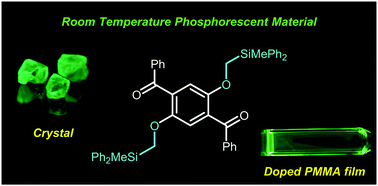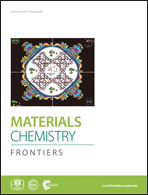Use of silylmethoxy groups as inducers of efficient room temperature phosphorescence from precious-metal-free organic luminophores†
Abstract
We designed and characterized 1,4-diaroyl-2,5-bis(silylmethoxy)benzenes as precious-metal-free organic luminophores that efficiently phosphoresce at room temperature. The benzene derivatives in crystals emit green phosphorescence with quantum yields up to 0.45 under ambient conditions. The luminescence quantum yield increases with increasing number of intermolecular interactions in the crystal, such as hydrogen bonding and CH–π interactions. The luminescence lifetimes are inversely proportional to temperature over the −80 to 80 °C range, demonstrating the potential of the benzene derivatives as materials for temperature sensing. Poly(methyl methacrylate) films doped with these luminophores also exhibit intense green phosphorescence at room temperature under vacuum, while they emit very faint blue fluorescence under ambient conditions. Electron spin resonance spectroscopy of a UV-excited diphenylmethylsilyl-derivative in toluene at 77 K reveals a triplet diradical species, whose electronic distribution is similar to that of naphthalene, indicating that the triplet diradical is distributed over almost ten atoms.

- This article is part of the themed collections: Materials Chemistry Frontiers HOT articles for 2018 and Pi conjugated system bricolage (figuration) toward functional organic molecular systems


 Please wait while we load your content...
Please wait while we load your content...